Verify originality of an essay
Get ideas for your paper
Find top study documents

How to Write Dialogue in an Essay: Usage, Formatting, Punctuation Rules
Updated 11 Mar 2024
From narrative essays , personal reflections, psychology simulation reports and up to English literature writing and scholarships, using dialogue in an essay can dramatically change student’s chances of delivering a successful paper. However, there are specific rules that have to be considered. Many U.S. college students have failed such essays due to not learning how to write dialogue in an essay. Our writing guide provides clear definition, cases of usage, formatting cases with examples, MLA and APA dialogue rules that have to be known. Thankfully, once these rules are mastered, chances of getting low grades are really low! For best grades, consider turning to one of our creative writers at EduBirdie to receive plagiarism free and unique papers.
Essay Dialogue Definition & Purpose
As most might remember from school, dialogue represents special literary device that helps writers to portray a conversation with two or more individuals involved. Dialogue in an essay can be implemented when writing fiction or nonfiction narrative work. As an example, working with (or citing) movies, plays, books or reports, its usage may even become obligatory for greater effect. However, one should not mistake dialogue with academic research necessity to directly quote from journals, books or any other sources.
The most crucial rule isn’t to confuse direct quotes with dialogues, which is a major mistake that most college students do. Main difference lies not only in formatting rules but in purpose. Purpose of dialogue is being a part of particular story, adding creative or emotionally-charged touch. Unlike direct quotes that have purpose of supporting claims made by an author word by word, it differs by primary intention.
_1554305439.jpg)
When Dialogue is Used in an Essay and Why
Naturally, cases of dialogue usage differ from paper to paper, yet majority of writing assignments that include dialogue have creative nature. It’s so because narration always tells a story and adds literary devices to support settings, writing style, and imagery. Psychological element of perception is extremely important, therefore, each sentence has to be creative. Dialogue in an essay adds power to imagery by allowing target audience to live through effect of an actual presence and character of people involved.
There can be various dialogue simulations in Business Management, Education or Psychology university assignments that require creative thinking, yet when students have to work with argumentative or persuasive essays, it’s recommended to apply direct quoting instead to make argumentation reliable. Since our claim has to be strong or even supported by a source, citing existing source is correct in such cases.
Likewise, working with expository essays students explain mechanics of certain facts by providing definite facts. General rule with understanding whether dialogue fits in your paper is thinking about importance of direct claims. If no claim has to be made, creative use of conversation is allowed. It helps to relate stories, knowledge, and feeling of belonging to an audience.
For example, when one has to present conversations with friends or work colleagues, writing an argumentative paper, it is recommended to use direct quotes, marking it as "Personal Interview" or "Personal Conversation", when citing. College professors expect students objectivity, correct attitude that shows scientific approach. Turning to dialogue essay is acceptable in narration or when writer has to be reflective.
Approach this task as a report on speech where there’s no need to include all details. Recreating it from one's memory, writer uses dialogue to add depth, emotional background or mood to explain provided story's content. Remember that conversation has to capture reader's attention, explain settings, and be realistic enough.
Try our all-in-one writing tool
- Check grammar, readability, and plagiarism
- Cite sources & rephrase text automatically
How to Format Dialogue in an Essay
The most challenging part is how to format dialogue in an essay, yet with basic rules explained, it will not seem too difficult!
Note: Our writing guide focuses on U.S. English rules of grammar, which means that it’s always better to check twice due to possible differences in your country.
- Apply double quotation marks when signifying that character uses speech
For example: When I failed college exams, my mother told me, "You should try harder, son."
- When using quotes in quotes, use single quotation marks
As shown below: "I recall watching Colbert Report episode that said 'Politics and religion do not mix' and feeling amazed," the course instructor said.
- If conversation extends across more than one paragraph, implement quotation marks right where each paragraph starts. However, closing double quotes can only be implemented when character’s speech reaches its end
See this example: James smiled and said, "It might be difficult at first. If we choose another approach for mediation, we won't be concerned about privacy. Still, third party presence might irritate people like John and Mike. Let's hope it works out."
Another important issue that should be considered by students learning how to put dialogue in an essay relates to correct punctuation. We will use correct and incorrect examples for clearer referencing.
- If your used speech quotation locates at sentence end, always implement full stop. It should be inside inverted commas, as in here:
Wrong use: His mother exclaimed, "Do your college homework right now, please".
Correct use: An old man commented, "This essay is worth gold."
- Speaking of questions or use of exclamation signs, there’s a rule that states if it’s related to character’s words, they should be placed inside quotation.
Incorrect: Johnny shouted, "This is against the rules"!
Correct: Linda commented, "Sounds right to me!"
- If quote belongs to another greater sentence that represents question or contains an exclamation in it, punctuation marks go beyond speech being marked.
Wrong quotation example: What would you think when professor says, "Have you seen additional grading rubric?"
Proper way: What did you do when your father shouted, "Where is Andrew"?
- If intended speech tag appears before you implement a quote, it is necessary to make it separate, therefore, writers put comma before quotation mark.
Wrong: His sister said, "I'm going to John's graduation tonight."
Correct: Mr. Brown said, "Essay writing online is possible".
- Now if conversation element appears after quotation marks, correct way is to place comma inside replica’s mark. Like this:
"Just make sure my tea is hot", my brother warned me as I went outside.
- Finally, if there is interruption in a phrase, it is necessary to put comma after the first part of used phrase. As explanatory part finishes (who speaks), comma is used once again. See our example:
"Not exactly," Tom said in teary voice, "It's plain wrong to think so."
Read also: To be confident in the explanatory part, read our guide about how to write an explanatory essay
Now that we know how to quote dialogue in an essay, let us proceed with APA and MLA formatting peculiarities!
Read also: How to Write Dates with Commas Correctly?
Dialogue Formatting in APA and MLA essay formats
MLA formatting:
- Place dialogue in new paragraph, even if speech is really small.
- Use commas to separate speech tags.
He said, "Oh, dear! I think we forgot to invite Jamie."
- If character's speech is more than one paragraph, start every paragraph with inverted commas.
- Remember that final quotation mark is placed at paragraph's end.
During his graduation, he said, "I did not think that Social Psychology is right for me, but then I started working part-time at our local shelter. It was a time changing experience! "Thanks to my college professors, my parents, everyone who has made it possible today."
How to quote a conversation in an essay APA format:
- In APA format , if character in speech uses not much text, the same paragraph contains dialogue tags and quotes.
- Commas are used for dialogue tags separation as well as quoting.
Laura said, "I'm feeling tired. Can you help me with my assignment?"
- If speech is more than 40 words, inverted commas should be at the beginning of every paragraph, as well as at conversation's end.
During our meeting, he said, "Nothing can be as damaging as working at college assignments few hours before deadline." "No proofreading is done when student is always hurrying up. I recommend online writing services if one absolutely needs professional help and has no time."
- If your dialogue involves more than two people, each person has his or her own paragraph in essay text.
"Ashley Construction Group. How can I help you?" She said. "Stella? I think John asked you to text him this morning. Could you?" He exclaimed.
Get your paper in 3 hours!
- Customized writing: 100% original, personalized content.
- Expert editing: polished, standout work.
✔️ Zero AI. Guaranteed Turnitin success.

Choose Affordable Essay Writing Help!
According to our writing experts at EduBirdie, the most crucial part of successful dialogue essay is proofreading. Having this fact in mind, we offer affordable proofreading services online along with plagiarism-free papers within specified deadlines. Turning to our writing services, one can be assured that dialogue essay received is top-notch!
Here is what makes our service unique and tailored to individual needs:
- Choose from list of writers based on credentials, essays completed, and subject
- Writing process involves direct contact with assigned writer
- 24/7 service support online
- Papers are proofread and free from plagiarism
- Essay templates, format checking, proofreading, logic, grammar check involved
- Free, unlimited essay revisions
- Even complex deadlines can be met timely
- Flexible prices
- Payment is released to writer only when you are fully satisfied
Was this helpful?
Thanks for your feedback, related blog posts, diversity essay: effective tips for expressing ideas.
In today's interconnected and rapidly evolving world, the importance of diversity in all its forms cannot be overstated. From classrooms to workpla...
Learn how to write a deductive essay that makes you proud!
Learning how to write a deductive essay may sound like a challenging task. Yet, things become much easier when you master the definition and the ob...
Learn how to write an extended essay correctly
This helpful article will provide all the necessary information to show you how to write an extended essay without mistakes. You will learn about a...
Join our 150K of happy users
- Get original papers written according to your instructions
- Save time for what matters most
How To Format Dialogue (includes examples)

Make Your Posts Search Engine Friendly
You fuss over the appearance of your blog and the words in your articles, but are your posts search engine friendly? Here’s how to make them shine.

Optimal Word Count for a Novel Manuscript
Whether you hope to get published the traditional way or plan to self-publish, the word count of your completed work is important. Here’s the scoop.

Pantser to Plotter
My brother wrote, “I’m a pantser. My guess is that you’re a plotter.” He was only partly right. Things aren’t always black or white.

Types of Foreshadowing (with Examples)
Foreshadowing is an essential ingredient in any good story. There are many ways authors foreshadow. Here are different types of foreshadowing with examples.
Join Our Newsletter
Join our newletter to receive the latest writing and storytelling tips and techniques.
Thank you for joining!
Join our list.
Get notified by email when new information is published.
You have Successfully Subscribed!
Pin it on pinterest.
How to Format Dialogue: Complete Guide
Dialogue formatting matters. Whether you’re working on an essay, novel, or any other form of creative writing. Perfectly formatted dialogue makes your work more readable and engaging for the audience.
In this article, you’ll learn the dialogue formatting rules. Also, we’ll share examples of dialogue in essays for you to see the details.
What is a Dialogue Format?
Dialogue format is a writing form authors use to present characters' communication. It's common for play scripts, literature works, and other forms of storytelling.
A good format helps the audience understand who is speaking and what they say. It makes the communication clear and enjoyable. In dialogue writing, we follow the basic grammar rules like punctuation and capitalization. They help us illustrate the speaker’s ideas.
General Rules to Follow When Formatting a Dialogue
Dialogue writing is an essential skill for both professionals and scholars . It shows your ability to express the issues and ideas of other people in different setups. The core rules of formatting are about punctuation. So, below is a quick reminder on punctuation marks’ names:
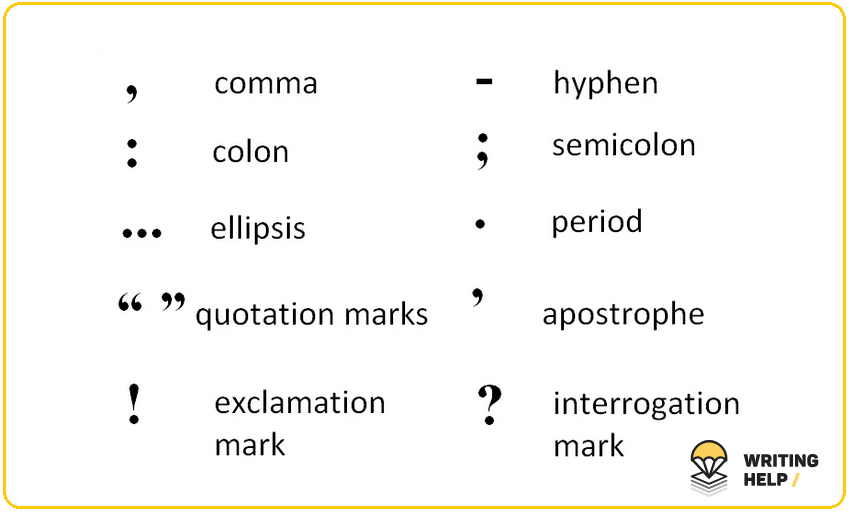
And now, to practice.
Please follow these rules for proper dialogue formatting:
- Use quotation marks. Enclose the speaker’s words in double quotations. It helps readers distinguish between a character’s speech and a narrator’s comments.
- Place punctuation inside quotation marks. All punctuation like commas, exclamations, or interrogation marks, go inside the double quotations.
- Keep dialogue tags behind quotation marks. A dialogue tag is (1) words framing direct speech to convey the context and emotions of a conversation. For example, in (“I can’t believe this is you,” she replied.), the dialogue tag is “she replied.”
- Use an ellipsis or em-dashes for pauses or interruptions. To show interruptions or pauses, end phrases with ellipses inside quotations. Em-dashes go outside quotations. No other extra marks are necessary here.
- Remember a character’s voice. Ensure that each character’s phrases reflect their background and personality.
5 More Rules to Know (+ Examples of Dialogue)
For proper formatting of dialogue in writing, stick to the following rules:
1. Each speaker’s saying comes in a new paragraph
Begin a new paragraph whenever a new character starts speaking. It allows you to differentiate speakers and make their conversation look more organized. (2)
“Has Mr. de Winter been in?” I said. “Yes, Madam,” said Robert; “he came in just after two, and had a quick lunch, and then went out again. He asked for you and Frith said he thought you must have gone down to see the ship.” “Did he say when he would be back again?” I asked. “No, Madam.” — from Rebecca by Daphne du Maurier
2. Separate dialogue tags with commas
When using dialogue tags ( e.g., “she said,” “he replied,”), separate them with commas.
For example:
“You’ve got to do something right now , ” Aaron said , “Mom is really hurting. She says you have to drive her to the hospital.” “Actually, Dad , ” said Caleb, sidling in with his catalog , “There’s someplace you can drive me, too.” “No, Caleb.” — from The Corrections by Jonathan Franzen
3. When quoting within dialogue, place single quotes
If a character cites somebody or something while speaking, we call it a reported dialogue. In this case, use single quotations within double ones you place for a direct speech. It will help readers see that it’s a quote.
John started to cry. “When you said, ‘I never wanted to meet you again in my life!’ It hurts my feelings.”
4. You can divide a character’s long speech into paragraphs
Dialogue writing is different when a person speaks for a longer time. It’s fine to divide it into shorter paragraphs. Ensure the proper quotation marks placing:
The first quotation mark goes at the beginning of the dialogue. Each later paragraph also starts with it until that direct speech ends.
The second quotation mark — the one “closing” the monologue — goes at the dialogue’s end.
Josphat took a deep breath and began. “ Here’s the things about lions. They’re dangerous creatures. They only know how to kill. Have you ever seen a lion in an open area? Probably not. Because if you had you’d be dead now. “ I saw a lion once. I was fetching firewood to cook lunch. All of a sudden I found myself face to face with a lion. My heart stopped. I knew it was my end on earth. If it wasn’t the poachers we wouldn’t be having this talk. ”
Yet, you can keep a long text as a whole by adding some context with dialogue tags. Like here:
As you can see, there’s no quotation mark at the end of the paragraph in red. It’s because the next “Ha! ha!” paragraph continues the character’s speech.
5. Use action beats
Describe actions to provide context and keep readers engaged. Help them “hear” your characters. Punctuation also helps here: exclamation (!) or interrogation with exclamations (?!) demonstrate the corresponding tone of your narrative.
He slammed the door and shouted , “I can’t believe you did that ! “
Mistakes to Avoid When Formatting Dialogue
A good dialogue is a powerful instrument for a writer to show the character’s nature to the audience. Below are the mistakes to avoid in formatting if you want to reach that goal.
So, please don’t :
- Allow characters to speak for too long. Writing long paragraphs will bore the reader, making them skip through your speech. Short but sweet talk is the best. When writing, aim to be brief, dynamic, and purposeful. If your character speaks too much, generating opinion essays , ensure this speech makes sense and serves a bigger purpose.
- Overburden dialogue with exposition. Avoid telling the story background or building sophisticated words in your characters’ speeches. Instead, reveal the narrative content in small bursts and blend it around the rest of the prose. Convey it through your character’s actions and thoughts rather than summaries and explanations.
- Create rhetorical flourishes. Make your characters sound natural. Let them speak the way they’d do if they were real people. Consider their age, profession, and cultural background — and choose lexical items that fit them most.
- Use repetitive dialogue tags. Constant “he asked” and “she said” sounds monotonous. Diversify your tags: use power verbs, synonyms, and dialogue beats.
Frequently Asked Questions by Students
How to format dialogue in an essay.
Formatting a dialogue in an essay is tricky for most students. Here’s how to do it: Enclose the speaker’s words with double quotations and start every other character’s line from a new paragraph. Stick to the citation styles like APA or MLA to ensure credibility.
How to format dialogue in a novel?
A dialogue in a novel follows all the standard rules for clarity and readability. Ensure to use attributions, quotation marks, and paragraph format. It makes your dialogue flow, grabbing the reader’s attention.
How to format dialogue in a book?
Dialogue formatting in a book is critical for storytelling. It helps the audience distinguish the hero’s words. Follow the general rules we’ve discussed above:
Use double quotations and isolate dialogue tags with commas. Remember to place the discussion in blocks for better readability.
How to format dialogue between two characters?
A two-character dialogue offers the best way to prove successful formatting skills. Ensure you use action beats, quotations, and attribution tags. It allows readers to follow the conversation and understand it better.
What is the purpose of dialogue in a narrative essay?
Dialogue writing is the exchange of views between two or more people to reach a consensus. It reveals the character’s attitude and argumentation. Last but not least, it helps convey the descriptive nature of your narrative essay.
References:
- https://valenciacollege.edu/students/learning-support/winter-park/communications/documents/WritingDialogueCSSCTipSheet_Revised_.pdf
- https://www.ursinus.edu/live/files/1158-formatting-dialogue
- Essay samples
- Essay writing
- Writing tips
Recent Posts
- Writing the “Why Should Abortion Be Made Legal” Essay: Sample and Tips
- 3 Examples of Enduring Issue Essays to Write Yours Like a Pro
- Writing Essay on Friendship: 3 Samples to Get Inspired
- How to Structure a Leadership Essay (Samples to Consider)
- What Is Nursing Essay, and How to Write It Like a Pro
How to Write Dialogue in an Essay: Perfect Writing Guide
Writing essays is a part of every student’s life. The tool that can be useful for all composition genres with no limitations is dialogue. Typically, article writing at school and college is related to informative or argumentative intentions.
Dialogues can be included in reflective or narrative texts and creative assignments, such as screenplays. Likewise, if your paper is more on the argumentative side, you may include a dialogue when transcribing an extract from an interview to reinforce your thesis.
To get the highest mark for your paper, it is crucial to know how to write a dialogue in an essay. Keep reading this article to find out how to add it to your paper, whether for academic, informative, or creative purposes.
Usage of Dialogues in Essays
Over our educational years at school and university, we are taught to compose argumentative, narrative, informative, creative, and expository essays. Writing becomes a skill we need to develop to be successful when composing a report.
Quote, text line, or dialogue represents two or more characters talking, and can turn a dull paper into an easy-going and fun learning experience.
And just like when watching a movie, dialogues will have us more engaged in discovering the ending of the tale. Moreover, you will have a strong thesis for persuasive essay texts by including dialogues in them. How is this accomplished?
Dialogue serves more than just fiction, as we stated earlier. They transform information into a fluid and rhythmic piece of writing, providing data on an actual scenario portrayed as a conversation. This results in a direct and captivating piece that will teach and entertain the reader. That sounds like a win-win situation, right?
How to Format Dialogue in an Essay?
Here you will encounter some of the essential rules in terms of punctuation and formatting that should be followed when writing effective dialogue in your article so that it is read naturally. If you are unsure of your profile essay writing skills, keep reading this page to get accurate and precise information for composing your best paper.
- How to add dialogue in an essay: you can either use double quotation marks to indicate what someone said, or start in a new line using a Dash followed by the actually spoken phrase every time a new character speaks. This demonstrates that dialogue conversations have started.
“Elisa gave me this purse for my birthday.”
—Elisa gave me this purse for my birthday.
—It looks good on you.
—Thank you, I like it a lot.
- If you are quoting already, use single quotation marks to add another quotation within. This is useful when you depict someone describing a certain circumstance that happened to them.
“He was eating lunch next to me when Tom came by and yelled, ‘let’s go outside,’ so we went.”
- Make sure to use closing quotation marks when the character finishes talking. If dashes are used instead, end that person’s speech with a complete stop, showing that a dialogue has ended.
“I took my cat to the Vet last night to get a shot. He is alright now.”
- When a character is quoted, exclamation and question marks should be placed inside the quotation marks. If the exclamation or quotation marks refer to the greater sentence, not the quotation itself, place them outside the quotation marks.
My niece screamed, “let’s play hide and seek!”. What was your reaction when your niece screamed, “let’s play hide and seek”?.
- Do not add a period if the character pauses in the speech; in this case, write the speech, then use a comma to include a remark and add another comma before the last part of said speech.
“I couldn’t finish the presentation tonight,” he said with a tired voice, “I will tomorrow.”
- If a quote is too long, for example, longer than a paragraph in the essay, you can break it into two sections to make it easier to read. Such a situation is frequent when you write a narrative text. This type of assignment is often given to college and high school students. And it’s one of the most difficult tasks. If you need more confidence in your composition writing skills but still want to get a great mark and impress your teacher, we recommend you to buy narrative essays from professional writers. They will definitely know how to deal with complicated quotes. Here you can see an example of how a big direct quote was shortened to create a new paragraph for the text:
“Christmastime at work is very intense, and we work long shifts. Last year, we launched fifteen new products so that they were sold out during Christmastime. Luckily, it was a success. Our most popular items were: a Christmas cookie-scented candle, a new edition of the traditional elf-pet costume, and a unique knife that cuts the turkey easily and evenly.
I tried the candle immediately and loved the scent; my sister dressed her dog and three cats as elves, poor things, but she looked amused, and my mom tried the turkey knife; she genuinely said it was the best she could use to cut the turkey.”
How to Write Dialogue in an Essay?

Knowing how to put dialogue in your essay will allow you to bring out your creative side while mastering the skill of showing rather than telling. If you want to know particular features of writing a good process essay , read to master how to write a dialogue and search for relevant sentences. Also, you’ll need to craft coherent paragraphs, use speech tags and be aware of the format and punctuation rules when writing dialogue in your paper.
Common Dialogue Mistakes to Avoid
Mistakes are easy to make when we need to learn the rules of correct essay writing, so pay attention to the most common mistakes to avoid delivering an enjoyable and compelling text.
One of the most frequent mistakes students make when they need to learn how to put dialogue in an essay is confusing dialogue with citations. The latter is adequate when directly referencing, word-by-word, other authors to support statements previously made regarding a particular topic. At the same time, dialogues are supposed to deliver information by being creative and motivating the reader to relate to a life situation described in the dialogue.
Citation: also known as direct quotes, is information written by an author and referenced to support a claim.
Dialogue: a speech between two or more characters, often portrayed to captivate the reader, and what is used is only a part of a greater conversation.
Other mistakes to avoid in your text:
- Providing too many details and unnecessary talk can be counterproductive. Keep it simple.
- Repeating information from one word to another. Describe it in your own words or show it through dialogue formatting. This will make the topic more interesting as the teacher will use their imagination. If you need help with how to do it properly, we recommend asking for help from a specialized platform, such as Edusson.com . Here you will find professional writers who will write your article quickly, plagiarism-free papers with high quality, and at a reasonable price.
- Using more dialogue tags than required can distort the readability of the conversation.
- Mentioning the characters’ names often, which only happens in real talk, decreases credibility.
- Incorrect use of opening quotation marks.
Some types of articles would benefit from dialogues to bring more dynamics into them. Check to avoid the mistakes we presented to you, compose creatively, and most importantly, just as dialogue tells a story. It describes a scenery that will make the reader learn through real-life association, so use dialogue when you think it will add value to the text.
Example of Dialogue in an Essay
Here we will give you examples of how to add dialogue to an essay:
Do thorough research on the topic by looking up reliable sources Use an online plagiarism checker to ensure that your paper is unique Explain the purpose of your study, providing supporting arguments, examples, and close by validating the thesis mentioned at the beginning. If the topic you are writing about is rather technical, define the meaning of its relevant vocabulary Teach the reader, do not assume they know everything. Otherwise, they wouldn’t come to read Verify that your composition is cohesive and informative Finally, read both your text and dialogue out loud to check they are coherent and eloquent.
Knowing these dialogue rules, you are ready to write with confidence! Whether you are writing for college, creating a dialogue for fun, or just eager to learn about this topic, you already know the essentials of how to write a dialogue in your essay with the correct format and punctuation rules. Additionally, if you are ever in need of professional help for your writing, you can always opt to pay to write an essay to ensure that you are submitting a well-written, high-quality paper.
Related posts:
- 6 Step Process for Essay Writing
- How to Write a Diagnostic Essay (Without Fail)
- How to Write a Rhetorical Analysis Essay
- Footnotes 101: A Guide to Proper Formatting
Improve your writing with our guides

How to Write a Scholarship Essay

Definition Essay: The Complete Guide with Essay Topics and Examples

Critical Essay: The Complete Guide. Essay Topics, Examples and Outlines
Get 15% off your first order with edusson.
Connect with a professional writer within minutes by placing your first order. No matter the subject, difficulty, academic level or document type, our writers have the skills to complete it.
100% privacy. No spam ever.

- Features for Creative Writers
- Features for Work
- Features for Higher Education
- Features for Teachers
- Features for Non-Native Speakers
- Learn Blog Grammar Guide Community Events FAQ
- Grammar Guide
How to Write Dialogue in a Narrative Paragraph

Hayley Milliman

What is Dialogue?
How to write dialogue, how to punctuate your dialogue, periods and commas, question marks and exclamation points, final thoughts.
Dialogue is the written conversational exchange between two or more characters.
Conventional English grammar rules tell us that you should always start a new paragraph when someone speaks in your writing.
“Let’s get the heck out of here right now,” Mary said, turning away from the mayhem.
John looked around the pub. “Maybe you’re right,” he said and followed her towards the door.
Sometimes, though, in the middle of a narrative paragraph, your main character needs to speak.
Mary ducked away from flying fists. The fight at the pub was getting out of control. One man was grabbing bar stools and throwing them at others, and while she watched, another one who you could tell worked out regularly grabbed men by their shirt collars and tossed them out of the way. Almost hit by one flying person, she turned to John and said, “Let’s get the heck out of here right now.”
In my research, I couldn’t find any hard and fast rules that govern how to use dialogue in the middle of a narrative paragraph. It all depends on what style manual your publisher or editorial staff follow.
For example, in the Chicago Manual of Style , putting dialogue in the middle of paragraphs depends on the context. As in the above example, if the dialogue is a natural continuation of the sentences that come before, it can be included in your paragraph. The major caveat is if someone new speaks after that, you start a new paragraph and indent it.
On the other hand, if the dialogue you’re writing departs from the sentences that come before it, you should start a new paragraph and indent the dialogue.
The fight at the pub was getting out of control. One man was grabbing bar stools and throwing them at others, and another one who you could tell worked out regularly grabbed men by their shirt collars and tossed them out of the way.
Punctuation for dialogue stays consistent whether it’s included in your paragraph or set apart as a separate paragraph. We have a great article on how to punctuate your dialogue here: Where Does Punctuation Go in Dialogue?
It’s often a stylistic choice whether to include your dialogue as part of the paragraph. If you want your dialogue to be part of the scene described in preceding sentences, you can include it.
But if you want your dialogue to stand out from the action, start it in the next paragraph.

Dialogue is a fantastic way to bring your readers into the midst of the action. They can picture the main character talking to someone in their mind’s eye, and it gives them a glimpse into how your character interacts with others.
That said, dialogue is hard to punctuate, especially since there are different rules for different punctuation marks—because nothing in English grammar is ever easy, right?
We’re going to try to make this as easy as possible. So we’ll start with the hardest punctuation marks to understand.
For American English, periods and commas always go inside your quotation marks, and commas are used to separate your dialogue tag from the actual dialogue when it comes at the beginning of a sentence or in the middle. Here are a few examples:
Nancy said, “Let’s go to the park today since the weather is so beautiful.”
“Let’s go to the park today since the weather is so beautiful,” she said.
“Let’s go to the park today,” she said, “since the weather is so beautiful.”
British English puts the periods and commas inside the quotation marks if they’re actually part of the quoted words or sentence. Consider the following example:
- She sang “Somewhere Over the Rainbow”, the theme song from The Wizard of Oz.
In the above example, the comma after “Rainbow” is not part of the quoted material and thus belongs outside the quotation marks.
But for most cases when you’re punctuating dialogue, the commas and periods belong inside the quotation marks.
Where these punctuation marks go depends on the meaning of your sentence. If your main character is asking someone a question or exclaiming about something, the punctuation marks belongs inside the quotation marks.
Nancy asked, “Does anyone want to go to the park today?”
Marija said, “That’s fantastic news!”
“Please say you’re still my friend!” Anna said.
“Can we just leave now?” asked Henry.
But if the question mark or exclamation point is for the sentence as a whole instead of just the words inside the quotation marks, they belong outside of the quotes.
Does your physical therapist always say to his patients, “You just need to try harder”?
Do you agree with the saying, “All’s fair in love and war”?
Single Quotation Marks
Only use single quotation marks for quotes within quotes, such as when a character is repeating something someone else has said. Single quotes are never used for any other purpose.
Avery said, “I saw a sign that read ‘Welcome to America’s Greatest City in the Midwest’ when I entered town this morning.”
“I heard Mona say to her mom, ‘You know nothing whatsoever about me,’ ” said Jennifer.
Some experts put a space after the single quote and before the main quotation mark like in the above example to make it easier for the reader to understand.
Here’s a trickier example of single quotation marks, question marks, and ending punctuation, just to mix things up a little.
- Mark said, “I heard her ask her lawyer, ‘Am I free to go?’ after the verdict was read this morning.”
Perfectly clear, right? Let us know some of your trickiest dialogue punctuation situations in the comments below.
Are you prepared to write your novel? Download this free book now:

The Novel-Writing Training Plan
So you are ready to write your novel. excellent. but are you prepared the last thing you want when you sit down to write your first draft is to lose momentum., this guide helps you work out your narrative arc, plan out your key plot points, flesh out your characters, and begin to build your world. .

Be confident about grammar
Check every email, essay, or story for grammar mistakes. Fix them before you press send.
Hayley is the Head of Education and Community at ProWritingAid. Prior to joining this team, Hayley spent several years as an elementary school teacher and curriculum developer in Memphis, TN. When Hayley isn't hunched over her keyboard, you can find her figure skating at the ice rink or hiking with her dog.
Get started with ProWritingAid
Drop us a line or let's stay in touch via :

Guide to Writing a Dialogue in an Essay

Composing a dialogue is one of the most intricate parts of essay writing. Many students instantly realize that crafting a good dialogue within the context of a story takes a lot of time and requires more work that simply describing the events. And that’s not surprising as a dialogue should not simply present the direct quotations from different characters but bring the story to life.
If you are unsure about how to use dialogue in your essay, read on. Let’s figure out the main rules and standards together!
Moving the Story Forward
The main role of a dialogue is to help the story move forward by presenting conversations and thoughts. You can use a dialogue to speed up the pace of your essay if you feel that the narration slows it down or you can use it as a break between the long and overwhelming paragraphs. When writing conversations, you need to remember a few important things:
- Dialogues move the action, set the scene, explain the descriptions and predict the reactions and activities. They can do all these things at once, so don’t use the conversations to just convey the information.
- Remind yourself of the character’s voice to write a dialogue that sounds like a real speech . You may even use some grammatical mistakes to show the realistic conversation but make sure that you keep the balance between the actual talk and readability.
- Always use the speech as a characterization tool. From your words, a reader should understand a lot about the character: morality, background, appearance, etc.
To advance the story, your dialogues should sound natural, not forced, and clear. At the same time, the conversations have to convey the characters’ emotions and show the reader how they interact with each other.
Using Thoughts in Dialogue
Using thoughts and memories in the conversation can also show the important details of your story. This indirect dialogue is another way to change ideas without the quotations. You may also use a combination of direct and indirect dialogue for emphasis. It looks like this:
Billy and I moved on to the next painting. “That’s the ugliest thing I’ve ever seen.” He curled his lip in disgust. Well, I thought he was the ugliest thing I’d ever seen, and told him so. “And also, you stink. But most of all, your taste in art stinks.”
To reveal emotions and thoughts, you need to use the sensory details: tasting, smelling, hearing, seeing. Try to show what is going on, don’t tell. Thus, your essay will be more realistic and engaging for your reader.
Formatting Your Dialogue
The right format and style are key to the successful dialogue. Correct punctuation, tags and paragraphs are even more significant than the quotations themselves. Without following the main rules, it would be hopelessly confusing to understand who is speaking. Therefore, make sure that you format your dialogue accordingly.
Rule 1: Punctuation goes inside quotations.
“I’ll call you tomorrow!” Anna screamed.
Make sure to use two quotation marks for speech and one mark for speech within the speech. Even such a small thing as using the quotation marks can poorly reflect on your essay .
Rule 2: A new speaker – a new line.
If you have several characters in your essay, it’s important to know who is speaking. With the line break, your reader won’t be confused.
“I wish I could fly,” John said longingly. “Why don’t you grow wings, then?” Sarah snapped back.
If there is the action connected with a character, describe it in the same paragraph, then start a new line.
Rule 3: Break up dialogue in two parts.
It’s annoying to wait until the end of a speech to put a dialogue tag because it is unclear for a long time who is speaking. That’s why is it better to write the first thought, place a comma and tag, and then continue the dialogue.
“I can’t believe I failed the exam,” said Ben. “I studied and studied, but somehow I choked and left most of it blank.”
As you see, all dialogues follow a simple guideline. Keep the main rules in mind and start writing a dialogue to convey your message!

Related Posts

WAIT! Do you need help with your essay?
Enter your email to get 15% off your first order.

The discount is in your inbox.
- Tips on How to Write Dialogue in an Essay with Ease
- How to Format Dialogue: Examples and Writing Tips
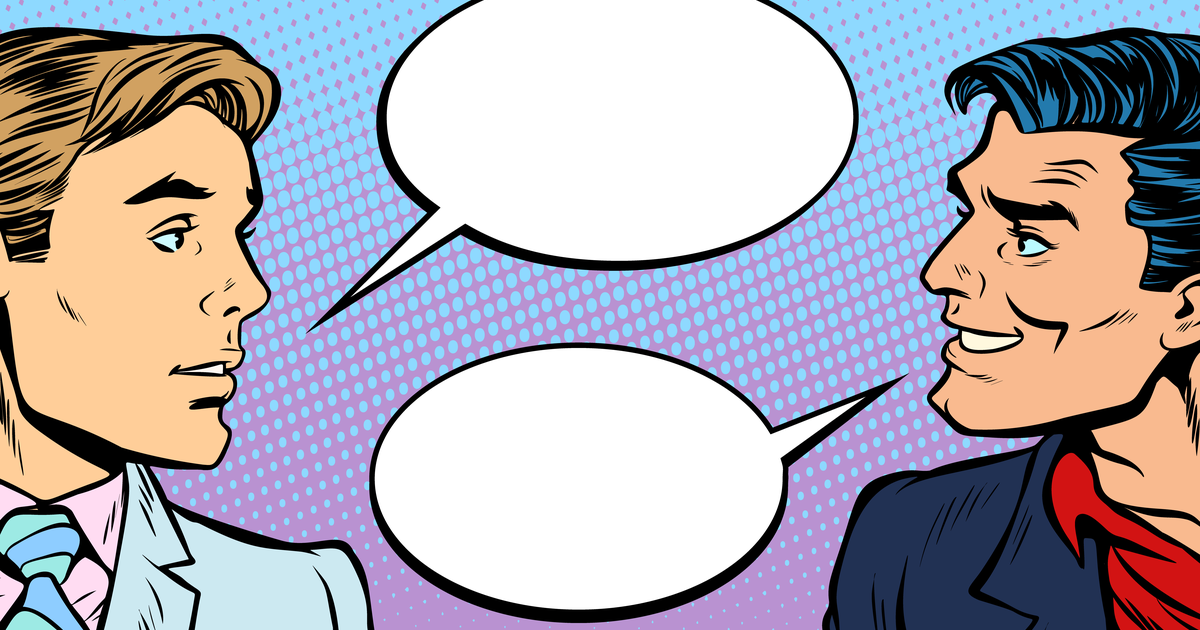
What Is a Dialogue and Its Types?
How to format dialogue in an essay, quotation marks and capitalization.
- Punctuation
Reporting Verbs and Dialogue Tags
How to quote a dialogue in an essay correctly, effective tips on dialog writing, final thoughts.
Sometimes adding a dialogue to an essay is the right way to improve the paper and receive a higher grade. Dialogue is a great device to describe the situation, characters, or emotions. Yet often, wrong formatting may adversely impact your piece of writing. This is a tricky aspect of a dialogue writing process, as it has so many nuances. This guide by Write My Essay 4 Me will help you learn how to format dialogue correctly and give a comprehensive list of writing, punctuation, and capitalization tips as well as perfect examples.
Dialogue is a written or spoken conversation between two or more people. It is widely incorporated in different written works, movies, and even computer games.
Writing dialogue in an essay will surely brighten up the story and captivate the reader. However, in terms of academic writing, it can be used in one essay type only; namely, the narrative essay. If you decide to add it to your essay, keep it realistic, clear, and to the point as well as format dialogue appropriately. If you are looking for a simple shortcut, you can pay to 'write my essay'. In case you want to find out useful tips, just keep on reading.
There are two types of dialogues you should keep in mind:
- Inner dialogues are used to convey what characters say to themselves or think.
- Outer dialogues are even more wide-spread and happen between several characters in the story.
Quite often students receive assignments to analyze or reflect on stories or books. They might add quotations from these sources as evidence. At this point, it is important to understand the difference between a direct and indirect quote. Both use information from the original source, but the difference is in presentation.
Writing dialogue that is clear and informative requires the knowledge of a set of formatting rules. You should understand how to punctuate dialogue correctly to convey the meaning properly. Check the rules to learn how to write dialogue correctly to make your piece of writing flawless.
Punctuation
- Use a comma after the dialogue tags that precedes direct speech.
- Use colon to introduce direct speech that expresses a finished idea or sentence.
- Do not add a comma after the direct quote that precedes a dialogue tag if the direct speech ends with its specific punctuation (i.e. full stop, exclamation or question marks, etc.).
- In case the quoted speech is too long, divide it into multiple paragraphs. Use quotation marks appropriately. Opening quotation marks should be placed at the beginning of the speech. Closing quotation marks go at the very end of the direct speech. Avoid adding them after every paragraph.
- Do not add any punctuation marks after the closing quotation marks if the direct speech ends with ellipsis. Ellipses (three dots) are used when you omit some information from the quote.
- Em dashes that indicate abrupt ending of a dialogue go inside the quotation marks. Do not mix up em dashes and hyphens.
- Avoid using either double or single quotes when you are introducing an indirect quote. It will be a mistake.
Dialogue tags or speech tags are short phrases that refer to the direct quote. They provide additional information on what the character is speaking about, help explain the emotion, and understand the context better. They can be placed either before, in the middle, or after the direct quotation. These short phrases are also part of indirect speech.
When using indirect quotes, students tend to overuse word say and tell to present every. However, there exist multiple words that could help describe the dialogue better. Check the list of useful verbs to use in your dialogue tangs and indirect quotes.
Students are always required to cite the sources they have used in paper. These can either be long or short direct quotes, dialogues, or paraphrase. Dialogue punctuation depends on the formatting style. The most common are MLA and APA. Although, there are other styles such as Chicago and ASA format . Let's have a look at the rules to punctuate dialogue and direct quotes correctly.
When quoting a dialogue in MLA format, you should pay attention to the following requirements.
- When adding a direct quote, always mention the author and page number it is taken from.
- If you add words to a quotation, add brackets around them to show they are not part of the original text.
- If the quotation is too long or contains irrelevant information for you add ellipsis to indicate some information was omitted.
- When adding indirect quotes, do not add either double or single quotation marks.
Mind the following dialogue rules when formatting quotations in APA format.
- If a character’s quote is short, put both the quote and the dialogue tags in the same line.
- When adding a quote that is longer than 40 words, first, introduce the source and the author. Put a colon and add a quote as a new paragraph. The whole quote should be indented, and no quotation marks are needed. Mention the page quote is taken from in brackets just at the end of the quotation.
- If a character’s words span more than one paragraph, put quotation marks at the beginning of paragraphs as well as at the end of the quote.
- Indirect quote in APA does not require the use of quotation marks. The dialogue tags initiate the character’s part.
- Use quotation marks at the beginning and end of each quotation.
- Every quote starts from a new line of dialogue.
- Separate direct speech from dialogue tags using corresponding punctuation marks.
- Use different placing of dialogue tags (before, in the middle, after a quote) to avoid repetitive structures.
- Original direct speech punctuation goes within quotation marks.
- Use different verbs in a dialogue tag.
- Formatting dialogue in APA and MLA is different.
- Differentiate between direct and indirect quotes.
- Don’t add quotation marks if you paraphrase.
- Use single quotation marks to add one direct quote within another.
We have a lot of useful blogs for our users. Read how to write an essay quickly and follow all these tips. Use our examples for writing different kinds of tasks.
Writing dialogue is a time consuming process. It has numerous tricky rules. Now that you know all the peculiarities of dialogue writing, such as dialogue tags, em dashes, quotation marks, it will not be a challenge for you to write dialogue. However, if you are not sure you can do it the right way, you may try writing assistance. Professional writers will help you save time and receive high grades.
Before you start writing an essay, it is essential to know your goal and what thoughts you want to deliver to your reader. An essay outline serves as a skeleton of the paper you are going to write. It can be a bit more complicated to develop a well-written essay if you have no structure to follow. Y...
Students face the necessity to write lots of essays. Balanced paragraph and topic sentences are an inevitable part of any good paper. They express the main idea of a paragraph, informing the reader what it is about, and help make the paper coherent. Good topic sentences have some compulsory elements...
Writing a thesis statement may seem to be an impossible task at first. There’s a good reason for that! It may not be simple to convey the idea of the whole essay in one or a couple of sentences. But no worries! With the right guidance, it can be done easily. With practice, it will become as easy as ...
- PRO Courses Guides New Tech Help Pro Expert Videos About wikiHow Pro Upgrade Sign In
- EDIT Edit this Article
- EXPLORE Tech Help Pro About Us Random Article Quizzes Request a New Article Community Dashboard This Or That Game Popular Categories Arts and Entertainment Artwork Books Movies Computers and Electronics Computers Phone Skills Technology Hacks Health Men's Health Mental Health Women's Health Relationships Dating Love Relationship Issues Hobbies and Crafts Crafts Drawing Games Education & Communication Communication Skills Personal Development Studying Personal Care and Style Fashion Hair Care Personal Hygiene Youth Personal Care School Stuff Dating All Categories Arts and Entertainment Finance and Business Home and Garden Relationship Quizzes Cars & Other Vehicles Food and Entertaining Personal Care and Style Sports and Fitness Computers and Electronics Health Pets and Animals Travel Education & Communication Hobbies and Crafts Philosophy and Religion Work World Family Life Holidays and Traditions Relationships Youth
- Browse Articles
- Learn Something New
- Quizzes Hot
- This Or That Game
- Train Your Brain
- Explore More
- Support wikiHow
- About wikiHow
- Log in / Sign up
- Education and Communications
- Writing Techniques
How to Format Dialogue in a Story
Last Updated: December 23, 2023 Fact Checked
This article was co-authored by Diya Chaudhuri, PhD . Diya Chaudhuri holds a PhD in Creative Writing (specializing in Poetry) from Georgia State University. She has over 5 years of experience as a writing tutor and instructor for both the University of Florida and Georgia State University. There are 10 references cited in this article, which can be found at the bottom of the page. This article has been fact-checked, ensuring the accuracy of any cited facts and confirming the authority of its sources. This article has been viewed 453,409 times.
Whether you are writing fiction or nonfiction, satire or drama, writing the dialogue may have its challenges. The parts of a story where characters speak stand out from the other elements of a story, starting with the quotation marks that are nearly universally applied. Here are some of the most common and established steps for making sure that your story looks right when you have to figure out how to properly format dialogue.
Things You Should Know
- Break and indent paragraphs involving 2 or more speakers.
- Use quotation marks around all words spoken by a character.
- Break a long speech into multiple paragraphs.
Getting the Punctuation Right

- Even if a speaker only utters half a syllable before they’re interrupted by someone else, that half-syllable still gets its own indented paragraph.
- In English, dialogue is read from the left side of the page to the right, so the first thing readers notice when looking at a block of text is the white space on the left margin. [2] X Research source

- A single set of quotation marks can include multiple sentences, as long as they are spoken in the same portion of dialogue. For example: Evgeny argued, "But Laura didn’t have to finish her dinner! You always give her special treatment!"
- When a character quotes someone else, use double-quotes around what your character says, then single-quotes around the speech they’re quoting. For example: Evgeny argued, “But you never yell ‘Finish your dinner’ at Laura!”
- The reversal of roles for the single and double-quotation mark is common outside of American writing. Many European and Asian languages use angle brackets (<< >>) to mark dialogue instead.

- Use a comma to separate the dialogue tag from the dialogue.
- If the dialogue tag precedes the dialogue, the comma appears before the opening quotation mark: Evgeny argued, “But Laura didn’t have to finish her dinner!”
- If the dialogue tag comes after the dialogue, the comma appears before (inside) the closing quotation mark: “But Laura didn’t have to finish her dinner,” argued Evgeny.
- If the dialogue tag interrupts the flow of a sentence of dialogue, use a pair of commas that follows the previous two rules: “But Laura,” Evgeny argued, “never has to finish her dinner!”

- If the question or exclamation ends the dialogue, do not use commas to separate the dialogue from dialogue tags. For example: "Why did you order mac-and-cheese pizza for dinner?" Fatima asked in disbelief.

- For example, use a dash to indicate an abruptly ended speech: "What are y--" Joe began.
- You can also use dashes to indicate when one person's dialogue is interrupted by another's: "I just wanted to tell you--" "Don't say it!" "--that I prefer Rocky Road ice cream."
- Use ellipses when a character has lost her train of thought or can't figure out what to say: "Well, I guess I mean..."

- For example: Evgeny argued, "But Laura didn’t have to finish her dinner!" The “b” of “But” does not technically begin the sentence, but it begins a sentence in the world of the dialogue, so it is capitalized.
- However, if the first quoted word isn’t the first word of a sentence, don’t capitalize it: Evgeny argued that Laura “never has to finish her dinner!”

- Use an opening quotation mark where you normally would, but don’t place one at the end of the first paragraph of the character’s speech. The speech isn’t over yet, so you don’t punctuate it like it is!
- Do, however, place another opening quotation mark at the beginning of the next paragraph of speech. This indicates that this is a continuation of the speech from the previous paragraph.
- Place your closing quotation mark wherever the character’s speech ends, as you normally would.

Making Your Dialogue Flow Naturally

- When you have a long dialogue that’s clearly being held between only two people, you can choose to leave out the dialogue tags entirely. In this case, you would rely on your paragraph breaks and indentations to let the reader know which character is speaking.
- You should leave out the dialogue tags when more than two characters are speaking only if you intend for the reader to be potentially confused about who is speaking. For example, if four characters are arguing with one another, you may want the reader to get the sense that they’re just hearing snatches of argument without being able to tell who’s speaking. The confusion of leaving out dialogue tags could help accomplish this.

- Place dialogue tags in the middle of a sentence, interrupting the sentence, to change the pacing of your sentence. Because you have to use two commas to set the dialogue tag apart (see Step 3 in the previous section), your sentence will have two pauses in the middle of the spoken sentence: “And how exactly,” Laura muttered under her breath, “do you plan on accomplishing that?”

- Some examples of pronouns include I, me, he, she, herself, you, it, that, they, each, few, many, who, whoever, whose, someone, everybody, and so on.
- Pronouns must always agree with the number and gender of the nouns they’re referring to. [9] X Research source [10] X Research source
- For example, the only appropriate pronouns to replace “Laura” are singular, feminine ones: she, her, hers, herself.
- The only appropriate pronouns to replace “Laura and Evgeny” are plural, gender neutral ones (because English loses gender when pluralized): they, their, theirs, themselves, them.

Community Q&A
- Remember that less is often more. One common mistake that writers make when creating dialogue is to write things in longer sentences than people would actually say them. For example, most people use contractions and drop inessential words in everyday conversation. Thanks Helpful 0 Not Helpful 0
- Be very careful if you attempt to include an accent in your dialogue. Often, this will necessitate extra punctuation to show accent sounds ( danglin' instead of dangling , for example), and can end up visually overwhelming your reader. Thanks Helpful 0 Not Helpful 0

You Might Also Like

- ↑ http://edhelper.com/ReadingComprehension_33_85.html
- ↑ http://www.merriam-webster.com/dictionary/white%20space
- ↑ https://stlcc.edu/student-support/academic-success-and-tutoring/writing-center/writing-resources/quotation-marks-dialogue.aspx
- ↑ https://blog.reedsy.com/guide/how-to-write-dialogue/tags/
- ↑ http://learn.lexiconic.net/dialoguepunctuation.htm
- ↑ http://englishplus.com/grammar/00000106.htm
- ↑ http://www.chompchomp.com/terms/propernoun.htm
- ↑ http://www.grammarbook.com/grammar/pronoun.asp
- ↑ http://facweb.furman.edu/~moakes/Powerwrite/pronouns.htm
- ↑ https://www.sjsu.edu/writingcenter/docs/handouts/Pronouns.pdf
About This Article

To format dialogue in a story, insert a paragraph break and indent every time a new speaker starts talking. Then, put what they’re saying inside a set of double quotation marks. If you're using a dialogue tag, like "She said" or "He asked," follow it with a comma if it comes before the dialogue or a period if it comes after. Also, remember to put periods, question marks, and exclamation points inside the quotation marks. For more tips from our Creative Writing co-author, like how to write good, convincing dialogue, scroll down! Did this summary help you? Yes No
- Send fan mail to authors
Reader Success Stories
Mar 21, 2017
Did this article help you?
Steve Smith
May 18, 2020
John Shashenksi
Apr 25, 2017
Jun 17, 2016
Richard Jones
May 18, 2017

Featured Articles

Trending Articles

Watch Articles

- Terms of Use
- Privacy Policy
- Do Not Sell or Share My Info
- Not Selling Info
Don’t miss out! Sign up for
wikiHow’s newsletter
Looking to publish? Meet your dream editor, designer and marketer on Reedsy.
Find the perfect editor for your next book
1 million authors trust the professionals on Reedsy. Come meet them.
Guides • Perfecting your Craft
Last updated on Sep 21, 2023
How to Write Fabulous Dialogue [9 Tips + Examples]
This post is written by author, editor, and bestselling ghostwriter Tom Bromley. He is the instructor of Reedsy's 101-day course, How to Write a Novel .
Good dialogue isn’t about quippy lines and dramatic pauses.
Good dialogue is about propelling the story forward, pulling the reader along, and fleshing out characters and their dynamics in front of readers. Well-written dialogue can take your story to a new level — you just have to unlock it.
In this article, I’ll break down the major steps of writing great dialogue, and provide exercises for you to practice your own dialogue on.
Here's how to write great dialogue in 9 steps:
1. Use quotation marks to signal speech
2. pace dialogue lines by three , 3. use action beats , 4. use ‘said’ as a dialogue tag , 5. write scene-based dialogue, 6. model any talk on real life , 7. differentiate character voices, 8. "show, don't tell" information in conversation , 9. delete superfluous words, which dialogue tag are you.
Find out in just a minute.

Alfred Hitchcock once said, “Drama is life with all the boring bits cut out.”
Similarly, I could say that good dialogue in a novel is a real conversation without all the fluff — and with quotation marks.
Imagine, for instance, if every scene with dialogue in your novel started out with:
'Hey, buddy! How are you doing?"
“Great! How are you?""
'Great! Long time no see! Parking was a nightmare, wasn’t it?"
Firstly, from a technical perspective, the quotation marks are inconsistent and incorrectly formatted. To learn about the mechanics of your dialogue and how to format it, we also wrote this full post on the topic that I recommend reading.
Secondly, from a novel perspective, such lines don’t add anything to the story. And finally, from a reading perspective, your readers will not want to sit through this over and over again. Readers are smart: they can infer that all these civilities occur. Which means that you can skip the small talk (unless it’s important to the story) to get to the heart of the dialogue from the get-go.
For a more tangible example of this technique, check out the dialogue-driven opening to Barbara Kingsolver's novel, Unsheltered .
Screenwriter Cynthia Whitcomb once proposed an idea called the “Three-Beat Rule.” What this recommends, essentially, is to introduce a maximum of three dialogue “beats” (the short phrases in speech you can say without pausing for breath) at a time. Only after these three dialogue beats should you insert a dialogue tag, action beat, or another character’s speech.
Here’s an example from Jane Gardam’s short story, “Dangers”, in which the boy Jake is shooting an imaginary gun at his grandmother:

In theory, this sounds simple enough. In practice, however, it’s a bit more complicated than that, simply because dialogue conventions continue to change over time. There’s no way to condense “good dialogue” into a formula of three this, or two that. But if you’re just starting out and need a strict rule to help you along, then the Three-Beat Rule is a good place to begin experimenting.

FREE COURSE
How to Write Believable Dialogue
Master the art of dialogue in 10 five-minute lessons.
Let’s take a look at another kind of “beats” now — action beats.
Action beats are the descriptions of the expressions, movements, or even internal thoughts that accompany the speaker’s words. They’re always included in the same paragraph as the dialogue, so as to indicate that the person acting is also the person speaking.
On a technical level, action beats keep your writing varied, manage the pace of a dialogue-heavy scene, and break up the long list of lines ending in ‘he said’ or ‘she said’.
But on a character level, action beats are even more important because they can go a level deeper than dialogue and illustrate a character’s body language.
When we communicate, dialogue only forms a half of how we get across what we want to say. Body language is that missing half — which is why action beats are so important in visualizing a conversation, and can help you “show” rather than “tell” in writing.
Here’s a quick exercise to practice thinking about body language in the context of dialogue: imagine a short scene, where you are witnessing a conversation between two people from the opposite side of a restaurant or café. Because it’s noisy and you can’t hear what they are saying, describe the conversation through the use of body language only.
Remember, at the end of the day, action beats and spoken dialogue are partners in crime. These beats are a commonly used technique so you can find plenty of examples — here’s one from Never Let Me Go by Kazuo Ishiguro .
If there’s one golden rule in writing dialogue, it’s this: ‘said’ is your friend.
Yes, ‘said’ is nothing new. Yes, ‘said’ is used by all other authors out there already. But you know what? There’s a reason why ‘said’ is the king of dialogue tags: it works.
Pro-tip: While we cannot stress enough the importance of "said," sometimes you do need another dialogue tag. Download this free cheatsheet of 270+ other words for said to get yourself covered!

FREE RESOURCE
Get our Dialogue Tag Cheatsheet
Upgrade your dialogue with our list of 270 alternatives to “said.”
The thinking goes that ‘said’ is so unpretentious, so unassuming that it focuses readers’ attention on what’s most important on the page: the dialogue itself. As writer Elmore Leonard puts it:
“Never use a verb other than ‘said’ to carry dialogue. The line of dialogue belongs to the character; the verb is the writer sticking his nose in. But ‘said’ is far less intrusive than ‘grumbled,’ ‘gasped,’ ‘cautioned,’ ‘lied.’”
It might be tempting at times to turn towards other words for ‘said’ such as ‘exclaimed,’ or ‘declared,’ but my general rule of thumb is that in 90% of scenarios, ‘said’ is going to be the most effective dialogue tag for you to use while writing dialogue.
So now that we have several guidelines in place, this is a good spot to pause, reflect, and say that there’s no wrong or right way to write dialogue. It depends on the demands of the scene, the characters, and the story. Great dialogue isn’t about following this or that rule — but rather learning what technique to use when .
If you stick to one rule the whole time — i.e. if you only use ‘said,’ or you finish every dialogue line with an action beat — you’ll wear out readers. Let’s see how unnaturally it plays out in the example below with Sophie and Ethan:
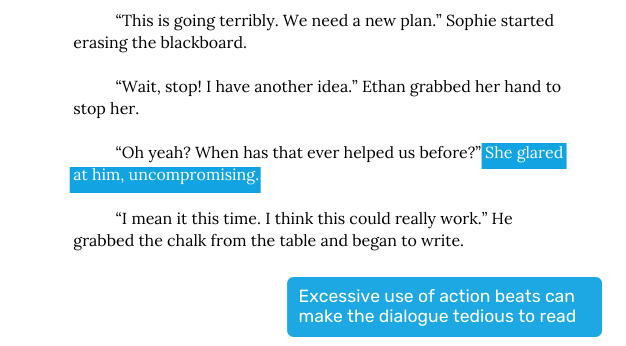
All of which is to say: don’t be afraid to make exceptions to the rule if the scene asks for it. The key is to know when to switch up your dialogue structure or use of dialogue tags or action beats throughout a scene — and by extension, throughout your book.
Tell us about your book, and we'll give you a writing playlist
It'll only take a minute!
Dialogue isn’t always about writing grammatically perfect prose. The way a person speaks reflects the way a person is — and not all people are straight-A honor students who speak in impeccable English. In real life, the way people talk is fragmented, and punctuated by pauses.
That’s something that you should also keep in mind when you’re aiming to write authentic dialogue.
It can be tempting to think to yourself, “ Oh, I’ll try and slip in some exposition into my dialogue here to reveal important background information.” But if that results in an info-dump such as this — “ I’m just going to the well, Mother — the well that my brother, your son, tragically fell down five years ago ” — then you’ll probably want to take a step back and find a more organic, timely, and digestible way to incorporate that into your story.

Kay Adams is Michael’s date at his sister’s wedding in this scene. Her interest in his family is natural enough that the expository conversation doesn’t feel shoehorned in.
A distinctive voice for each character is perhaps the most important element to get right in dialogue. Just as no one person in the world talks the same as each other, no one person in your book should also talk similarly.
To get this part of writing dialogue down pat, you need to start out by knowing your characters inside out. How does your character talk? Do they come with verbal quirks? Non-verbal quirks?
Jay Gatsby’s “old sport,” for example, gives him a distinctive, recognizable voice. It stands out because no one else has something as memorable about their speech. But more than that, it reveals something valuable about Gatsby’s character: he’s trying to impersonates a gentleman in his speech and lifestyle.
Likewise, think carefully about your character’s voice, and use catchphrases and character quirks when they can say something about your character.
Which famous author do you write like?
Find out which literary luminary is your stylistic soulmate. Takes one minute!
“Show, don’t tell” is one of the most oft-repeated rules in writing, and a conversation on the page can be a gold mine for “showing.”

Authors can use action beats and descriptions to provide clues for readers to read between the lines. Let’s revisit Sophie and Ethan in this example:
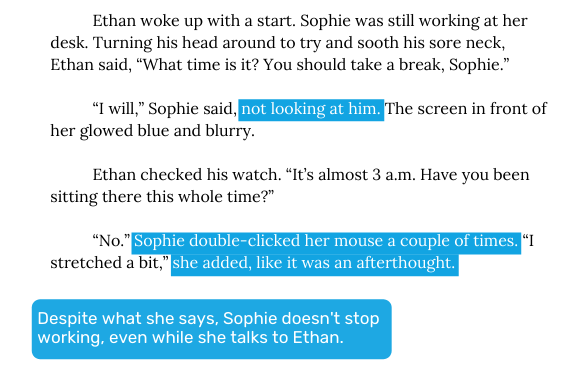
While Sophie claims she hasn’t been obsessing over this project all night, the actions in between her words indicate there’s nothing on her mind but work. The result is that you show , through the action beats vs. the dialogue, Sophie being hardworking—rather than telling it.

Show, Don't Tell
Master the golden rule of writing in 10 five-minute lessons.
As always when it comes to writing a novel: all roads lead back to The Edit, and the dialogue you’ve written is no exception.
So while you’re editing your novel at the end, you may find that a “less is more” mentality will be helpful. Remember to cut out the unnecessary bits of dialogue, so that you can focus on making sure the dialogue you do keep matters. Good writing is intentional and purposeful, always striving to keep the story going and readers engaged. The importance lies in quality rather than quantity.
One point I haven’t addressed yet is repetition. If used well (i.e. with clear intention), repetition is a literary device that can help you build motifs in your writing. But when you find yourself repeating information in your dialogue, it might be a good time to revise your work.
For instance, here’s a scene with Sophie and Ethan later on in the story:
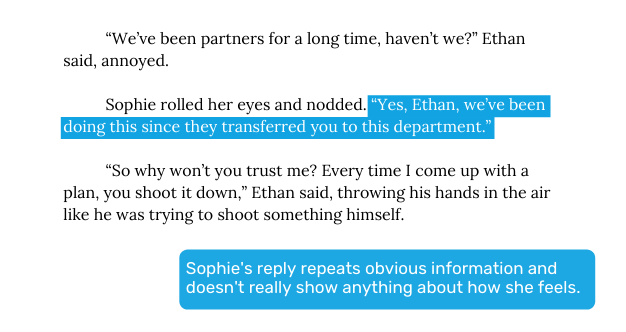
As I’ve mentioned before, good dialogue shows character — and dialogue itself is a playground where character dynamics play out. If you write and edit your dialogue with this in mind, then your dialogue will be sharper, cleaner, and more organic.
I know that writing dialogue can be intimidating, especially if you don’t have much experience with it. But that should never keep you from including it in your work! Just remember that the more you practice — especially with the help of these tips — the better you’ll get.
And once you’re confident with the conversational content you can conjure up, follow along to the next part of our guide to see how you can punctuate and format your dialogue flawlessly .

As an editor and publisher, Tom has worked on several hundred titles, again including many prize-winners and international bestsellers.
Join a community of over 1 million authors
Reedsy is more than just a blog. Become a member today to discover how we can help you publish a beautiful book.

Try our novel writing master class — 100% free
Sign up for a free video lesson and learn how to make readers care about your main character.

1 million authors trust the professionals on Reedsy. Come meet them.
Enter your email or get started with a social account:

How to Include Lines of Dialogue in an Essay
How to write english to russian.
When writing an essay for school, work or publication keep in mind the plagiarism laws that protect intellectual property. Any quotations used need to be properly marked and cited. Using quotations that are dialogue from a book, play or a program requires specific formatting.
Dialogue from a Book
Use double quotation marks (") around the entire quotation, if it is less than four lines. These signify that an excerpt from a resource is being used.
Use a single quotation mark (') around the words that are actually dialogue within a quote.
“'Teaching,' said Moody. 'Teach — Moody, is that a student?' shrieked Professor McGonagall, the books spilling out of her arms.” (from "Harry Potter and the Goblet of Fire" by JK Rowling. Scholastic: 2000, p.206.)
Use a set-off quotation for excerpts that are four lines or more. Indent the entire quotation, but do not use quotation marks around the excerpt. You will use them around the dialogue.
They spent the rest of the lesson taking notes on each of the Unforgivable Curses. No one spoke until the bell rang — but when Moody had dismissed them and they had left the classroom, a torrent of talk burst forth. Most people were discussing the curses in awed voices — "Did you see it twitch?" "— and when he killed it — just like that!" (Ibid., p. 218)
Do not close the dialogue with a quotation mark at the end of a paragraph if the same speaker continues dialogue at the beginning of the next paragraph. You will use a single quotation mark at the beginning of the second paragraph, then a single mark at the end of the quoted dialogue.
Double quotation marks will be around the entire excerpt (unless the passage is longer than four lines.)
“'He is at Hogwarts, that faithful servant, and it was through his efforts that our young friend arrived here tonight....
'Yes,' said Voldemort...'Harry Potter has kindly joined us for my rebirthing party. One might go so far as to call him my guest of honor.'” (Ibid. p 652)
Dialogue From a Play or Script
Format dialogue quotations for one speaker in a screenplay or dramatic script the same as you would from a book, as described in Section 1. If the quoted dialogue is four lines or less, use double quotations around the passage.
When Juliet says, "wherefore art thou, Romeo?" she is actually pining over why he is her family enemy rather than a more appropriate suitor. (Shakespeare, "Romeo and Juliet," 2.2)
Use a set-off quotation just as you do for long passages if you are quoting dialogue for two or more speakers. Indent the entire passage, but do not use quotation marks.
Type each character's name in capitals, followed by a period.
MACBETH. This is a sorry sight. [Looking at his hands] LADY MACBETH. A foolish thought to say a sorry sight. MACBETH. There's one did laugh in sleep, and one cried "Murder!" That they did wake each other. I stood and heard them; But they did say their prayers, and addressed them. Again to sleep. (Shakespeare, "MacBeth," 2. 2. 21-26)
Related Articles

How to Start an Introduction When Writing an Essay About Poetry

How to Punctuate Song Titles

How to Add Figurative Language to an Essay

How to Do Quotes on an Argumentative Essay in MLA Format
How to do citations for paradise lost.

What Is an Example of Foreshadowing in "Harry Potter and the ...

Narrative Techniques of Virginia Woolf

The Use of Figurative Language in "The Legend of Sleepy Hollow"
- MLA Citation guide
Based in Gloucester, Va., Janet Wooldridge is a freelance writer and proofreader who began writing professionally in 2008. Her work focuses on topics in education, environmentalism, child care, research and tourism. She holds an honors Bachelor of Arts in English with a minor in secondary education from the University of Florida.
- How to Cite
- Language & Lit
- Rhyme & Rhythm
- The Rewrite
- Search Glass
How to Use Dialogue From a Script in an Essay in MLA
Quoting dialogue between two or more characters from a script can seem like a daunting task, but knowing the origin of your script will make the task less challenging. Guidelines set forth by the Modern Language Association will also help make the process manageable.
Quoting Dialogue
Dialogue is the exchange between two or more characters within a script, whether for the purposes of a theatrical play or film. To format your quotation, begin the quote on a new line and indent it one inch from the body of your paper. If the quotation extends onto the next line, make sure to indent the second and subsequent lines another 1/4 inch, or about three spaces. Lines should be double spaced, and character names should be written in all capital letters, followed by a period. You should not use quotation marks when quoting dialogue from a script, play or film.
In-Text Citations
Because plays are often published differently from prose, MLA guidelines indicate that in-text citations should be contained in parentheses and consist of the act, scene and line number of the script, rather than the page number. To cite dialogue, begin with the broadest division and work toward the smallest division -- for example, from act to scene to line. Separate each of those divisions with a period. If you have noted the author and title of the script elsewhere in your paper, you do not need to include it again in the in-text citation. For example, the parenthetical citation (4.1.5-12) denotes that the quotation is from act 4, scene 1, lines 5 through 12.
Works Cited List
Published plays are generally found in either an anthology, a collection of a single author's works or a single volume. The source will dictate how the citation appears in the Works Cited list. However, scripts often have not been published in one of the previously listed formats. In this case, MLA considers it to be a manuscript and recommends that it be cited as such.
Works Cited Examples
A citation for an unpublished script is set up with the author's name (last name first), followed by a period; the title in italics, followed by a period; the type of work, followed by a comma; and the year. For example:
Baker, Stephanie. The Night Came. Unpublished script, 1998.
A script found online is more complicated to cite. It is set up with the authors first, followed by a period. Then, in italics, include the title, followed by a period. Then include the version of script, followed by a period. Then add the date of completion, followed by a period. The name of the site where the script was accessed, followed by a period, should come next. Then include the date of access, followed by a period. Finally, include the website address. For example:
Hill, Walter and David Giler. Alien. Revised Final Script. June 1978. The Daily Script. 3 Mar. 2008. http://www.dailyscript.com/scripts/alien_shooting.html.
Published scripts or plays by a single author are formatted with the author first, followed by a period. Then include the title in italics, followed by a period. Then add the publication city, followed by a colon. Then include the publisher, followed by a period. Then add the year, followed by a period. Finally, include the format, followed by a period. For example:
Williams, Tennessee. The Glass Menagerie. New York: Random House. 1945. Print.
- University of Toronto: MLA Formatting and Style Guide
- Georgia College: MLA Style
- Montgomery County Community College: How to Cite a Film Script
Alicia Anthony is a seasoned educator with more than 10 years classroom experience in the K-12 setting. She holds a Master of Education in literacy curriculum and instruction and a Bachelor of Arts in communications. She is completing a Master of Fine Arts degree in creative writing: fiction, and working on a novel.
- How It Works
- Essay Examples
How to Write Dialogue in an Essay
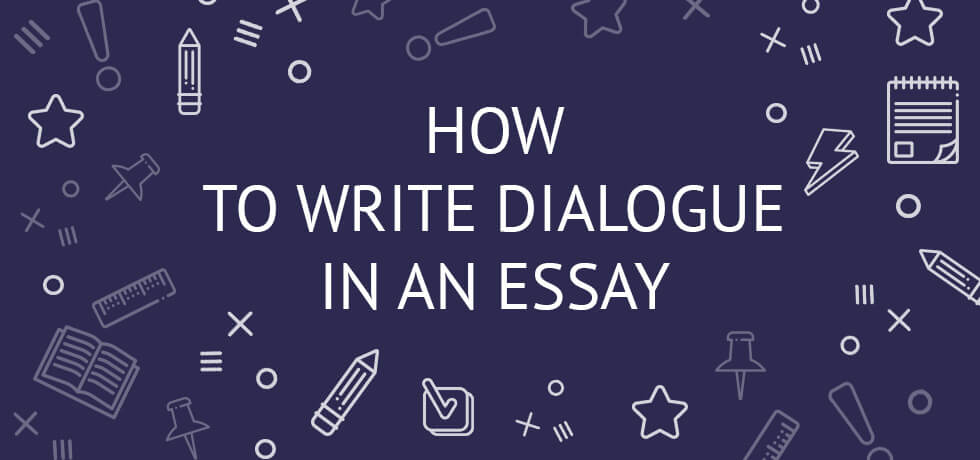
Knowing how to insert source materials into an essay is a central theme of academic writing. Sources can be cited to support your argument, expand it or even to be used to dissect a counter-argument and examine its validity.
This skill is so essential the rules of using quotation marks of when quoting texts are pounded into the student’s head. So much so you know when to quote a textual source and the reason to do so.
One of the areas many students struggle with is when or how they should use dialogue in an essay. A high number of essay writers don’t even know the difference between dialogue and quotes, let alone the correct punctuation surrounding it. The main reason it happens is because a large number of academic subjects focus solely on claim-based essays where dialogue is not used. This article will look at why dialogue can be so effective within a narrative essay and why. The topics discussed will be:
What is dialogue?
When do you use dialogue?
Why use dialogue?
How to write dialogue?
And Where you can find more information on this subject.
Dialogue: A definition
Dialogue is defined as a literary technique that writers use to depict a conversation between two or more people. Dialogue is a device that is employed in all kinds of fiction – movie, plays, books and can even be used in essays. It's important not to confuse dialogue with quotations from an outside source. Dialogue is largely made up to create a more visual, dramatic effect. Whereas direct quotes can be verified through citations.
Quotation marks are used with quoting from source as well as to mark dialogue in an essay but the conventions around the two change. As such, it is important to know the difference between the two.
Here is a small table that documents the main differences.
| Conversation between 2+ people | Information from a source used word for word |
| Occurs in a story (book, movie, play) | Used to support evidence |
| Is a device used by writers Report/Created Speech Should be included in Narrative Essays | Used to evaluate counter-claims Verifiable Speech Should be used in claim based essays |
One of the biggest mistakes an essay writer makes is when they use dialogue as a direct quote. This mistake occurs as we are trained to use speech as direct quotes in claim-based essays. As we are trained to do this in the majority of our subjects, we don't know that we can use crafted narration and create dialogue in narrative essays to give them more weight. Due to this, we do not understand the conventions around its use or why to use it.
Dialogue: When to Use it.
Dialogue is a big part of the movies, television, novels, and plays. It is important to keep in mind that when it comes to essay writing, a dialogue only really appears in one type of essay – the narrative essay.
A narrative essay differs from most kinds of essay writing. Other types of essays often aim to make a claim about something. If we look at an argumentative essay , for example, it makes a claim that one point of view is right. And an expository essay will make claims about how a model or idea works. A narrative essay doesn't make claims like this. It is an essay that is used to relate stories and experience to the reader, and as such, it is much more story like in nature. These experiences include conversations the writer has had with other people.
Presenting conversations you had with friends as dialogue in an argumentative essay or expository piece wouldn’t do much to strengthen your argument and would undermine your creditability. It is better to use direct quotes from the source – even if it is spoken material. Direct quotes will be seen as the conventional norm as these types of essay expect the writer to be objective and scientific in their discussion.
Dialogue: Why do you use dialogue
Narrative essays use dialogue as a device – much like written fiction. They add depth, tension and character development to nonfiction writing. It also helps move the story along. As it is reported speech, you would be unlikely to remember all the details; so, you will have to recreate them from memory – remember to use the words, tones, and emotions that report it in the correct flavor. Readers will trust realistic dialogue that captures the situation.
Dialogue: How to format
This section will demonstrate the correct formatting conventions to use when inserting your dialogue into a narrative essay. This section will look at the correct usage of the quotation marks, and where to put other punctuation marks. This will be looking at the U.S rules of grammar – the formations and convention in other variants of English might differ.
Quotations Marks
There are three main rules that surround the usage of quotation marks:
Double quotation marks are used to signify that a person is using speech.
Example: - When I was young, my father warned me, “Look in both direction before you cross the road.”
Single quotation marks are used to mark quotes in quotes.
Example: - “I remember read Oscar Wilde’s quote ‘I can resist everything except temptation’ and feeling so inspired,” the creative writer coach said.
When dialogue extends across several paragraphs, use quotation marks at the start of each paragraph, but only use the closing quotation make when the speech ends.
Example: - Rupert nodded and said, "Yeah I think you're correct. If we lay the carpet before painting the ceiling, we'll need dust sheets.
But if we do the ceiling before laying the new carpet it should be fine.”
If the quote is at the end of a sentence, always put the full stop inside the quotation marks.
Incorrect: - The bus driver said, “This is your stop”.
Correct: - The bus driver said, “This is your stop.”
Question marks and exclamation should be placed inside the quotation mark if they apply to the person's speech.
Incorrect: - The boy screamed, “Watched out the ceiling is falling”!
Correct: - The boy screamed, “Watched out the ceiling is falling!”
When the quote is simply embedded in a larger sentence that is a question or exclamation the punctuation should be placed outside the speech marks.
Incorrect : -How did you feel when the newscaster said, “JFK had been shot?”
Correct: - How did you feel when the newscaster said, “JFK had been shot”?
If a speech tags fall before the quote use a comma before the quotation marks to separate them.
Incorrect: - My brother said “I’m telling mom that you stole the cookies from the jar.”
Correct: - My brother said, “I’m telling mom that you stole the cookies from the jar.”
If the speech tag comes after the quotation marks, then the coma should be placed in the speech marks
Incorrect: - “Just be back in time for tea” My mum warned me before I went to play.
Correct: - “Just be back in time for tea,” My mum warned me before I went to play.
When a sentence is interrupted with a speech tag, a comma should be placed after the first segment of speech and at the end of the speech tag.
Incorrect: - “No” Karen said wrinkling her nose in disgust “That’s just all kinds of wrong.”
Correct: - “No,” Karen said wrinkling her nose in disgust, “That’s just all kinds of wrong.”
It is important to learn how to use quotation marks and punctuation correctly. These rules act as a convention between reader and writer, and as such, using them will make your work easier to read and understand. Without following these rules, your dialogue might be confusing and messy to the reader, which means it will not convey the message you want it to.
Dialogue: Where to find more resources
Here is a collection of some great links that will aid you in crafting the perfect narrative essay , and making sure you get your dialogue quotation spot on. You’ll be writing an amazing narrative essay in no time at all.
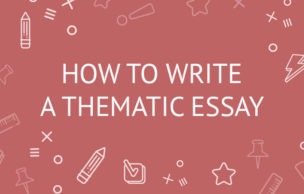
- Resume Writing Tips
- How to Write a Research Paper That Will Get You an A+
- Why Is College So Expensive?
- Essay About Traveling: The most unexpected benefits of seeing the world
- Dissertation Methodology: How To Make It Right


Dialogue: The Dos and Don’ts of Quotes in Your College Essay
“Hey,” I began, “you have cow eyes. I know that sounds like a bad thing but have you ever looked into a cow’s eyes? They are so deep and brown and beautiful. I’ve looked into a lot a cow eyes because I’m from Wisconsin.”
This dialogue segment is from Malcolm Conner’s winning “Modern Love” College Essay , p r i n t e d j u s t a c o u p l e m o n t h s a g o i n t h e N e w Y o r k T i m e s . Without dialogue, he might have said “I fumbled with my words, trying to compliment her,” but the dialogue shows his rambling and awkward demeanor instead.
Dialogue is an underutilized tool in the college essay. So many students don’t even consider adding an outdated adage from a parent or a hilarious crack from a high school coach to break up their prose, set the scene or build the profiles of their stories’ characters. And yet, dialogue is one of those devices that can give you a lot of bang for your buck, delivering a punch of personality or a wallop of context using just a few carefully culled utterances. Dialogue is also one of those tools that is easy to waste if you don’t know how to wield it for maximum effect. So when should you use dialogue in your college essay? And when should you avoid it?
Use dialogue:
If it reveals something specific about a character in your essay. Is your character cranky? A jokester? Is your character selfish? (“You can’t have any.”) Dialogue can telegraph these kinds of qualities to a reader very quickly.
If it helps to move the story forward. Maybe when everything is going great, your friend pulls you aside and says, “I have to tell you something, something bad.”
If it expresses humor or heartache or other emotions in the character’s own words. Is your character a funny grandparent? (“If you eat any more potatoes, Ireland’s gonna come for you, sport.” “Honey, if I had known about senior discounts, I would have let my hair go grey twenty years ago.”)
Don’t use dialogue:
If it is expressing something that is obvious to the reader without adding an additional layer of context or insight to the story or your characters. If it doesn’t tell us anything new about the character, the story may be better without it.
If you’ve already used it a few times in your essay. The impact of dialogue is enhanced when it’s used sparingly — especially in short pieces of writing.
If it takes away from the focal point of your story. Dialogue can be great insight into a character or situation, but if it doesn’t serve a purpose in hitting home your main point, it needs to be cut.
All of this said, of course, there are exceptions to these rules. If used intentionally, as a conscious creative choice, submitting an essay overflowing with dialogue can actually work to amazing effect. For example, maybe your essay is a discussion between you and your former self, between you and your best friend, or you and your parent. In these cases, you should ask yourself: why is this the best way to share my story? If you can answer that question and still believe you’re making the right choice, by all means, continue with your experiment.
Otherwise, the tips above should help you on the road to incorporating the right kind and amount of dialogue into your college essay. When used well, dialogue illuminates. It shows personality. It’s specific. I say, “Do it! Do it! Do it!”
About CEA HQ
View all posts by CEA HQ »
Give College Essay Academy a Try.
Written by CEA HQ
Category: Admissions , advice , College Admissions , Essay Tips , Essay Writing , Quick Tips , Tips , Uncategorized
Tags: 2017-2018 college applications , college admissions , college admissions essay , college applications , college essay , college essay help , college essay tips , dialogue , Essays

Want free stuff?
We thought so. Sign up for free instructional videos, guides, worksheets and more!

One-On-One Advising
Common App Essay Prompt Guide

Supplemental Essay Prompt Guide
- YouTube Tutorials
- Our Approach & Team
- Undergraduate Testimonials
- Postgraduate Testimonials
- Where Our Students Get In
- CEA Gives Back
- Undergraduate Admissions
- Graduate Admissions
- Private School Admissions
- International Student Admissions
- Common App Essay Guide
- Supplemental Essay Guide
- Coalition App Guide
- The CEA Podcast
- Admissions Stats
- Notification Trackers
- Deadline Databases
- College Essay Examples
- Academy and Worksheets
- Waitlist Guides
- Get Started
Questions? Call us:
Email:
- How it works
- Testimonials
Essay Writing
- Essay service
- Essay writers
- College essay service
- Write my essay
- Pay for essay
- Essay topics
Term Paper Writing
- Term paper service
- Buy term papers
- Term paper help
- Term paper writers
- College term papers
- Write my term paper
- Pay for term paper
- Term paper topic
Research Paper Writing
- Research paper service
- Buy research paper
- Research paper help
- Research paper writers
- College research papers
- Write my research paper
- Pay for research paper
- Research paper topics
Dissertation Writing
- Dissertation service
- Buy dissertation
- Dissertation help
- Dissertation writers
- College thesis
- Write my dissertation
- Pay for dissertation
- Dissertation topics
Other Services
- Custom writing services
- Speech writing service
- Movie review writing
- Editing service
- Assignment writing
- Article writing service
- Book report writing
- Book review writing
Popular request:
How to quote a dialogue answer’s here.
June 7, 2019
It is essential to understand the meaning of quoting dialogue before we learn how to quote dialogue in an essay. As you continue to write your essay, you may wish to refer to what other people said without making any changes to their phrases. The application of quotes comes in handy at this place. You can refer to the statements of other people in two ways. You can either use active or reported speech. Quotation involves the use of direct speech as you are referring to what another person said directly.

Importance of Writing Dialogue in an Essay
Several benefits come with quoting dialogue in your essay. These include:
- It makes your statement more valid because you are using the words of another person to refer to a point. It is good to have reference in your work as it will help the reader to understand the origin on your arguments and there will be no doubt especially if it is a quote dialogue.
- Quote dialogue also displays your proficiency in grammar. Most people don’t include quotations in their essays because they need to follow some punctuation rules such as having a comma before quotation. Most students prefer reporting like quoting because they don’t want to mess up with the set guidelines.
- Quotes make your essay outstanding because the reader will get first-hand information the way it was said. When reporting dialogue, you can omit some words that are crucial in supporting your points. However, when you use quotations, you are sure that you will state everything and hence your essay will have strong points.
It is good to use long quotes as long as you adhere to the set rules. If you don’t know how to quote dialogue, seek for help as this can change the meaning of your work and mess it up. Here are some of the things that you need to put into consideration before moving further.
Tips on How to Quote Dialogue in an Essay
- Don’t quote all the sections of your essay. Inserting too much quotations in your paper will make it boring to the readers as you will tend to over-rely on the words from other people. It will reduce the originality of your paper and the reader may undermine your creative ability as you are depending on the words of other people.
- Let your quotes be precise and avoid anything that is not related to the context of your writing. Do an analysis of the quote you wish to use and make sure that the impression that you are bringing out from the dialogue is related to what the essay is talking about.
- Only quote the words that vividly relate to what you are discussing in the essay. You will not have an organized piece of work if you just quote haphazardly. You may find yourself bringing up another meaning that is completely contrary to what you were saying.
- Avoid including long quotes in your essay because they can confuse your reader and make him fall off from your essay.
How to Quote Dialogue Example
There are different rubrics and formats for follow when quoting various phrases in your college essay. It all depends with the type and length of dialogue that you are referring. Here are a few illustrations for various quotes:
- Quoting a Short Paragraph That Has Less Than Four Lines
James insisted on the spying character of Desmond unworthy in the book: “The scholar’s eyes glowed so much on her that Dominic held her over his heart.” (Think wise 88)
- Quoting a Whole Passage
It will help you to summarize and not write the whole passage. You will refer to the passage using the simplest form of quotation. The use of length quotations in an essay is not a good practice in writing. It is good to make them as short as possible.
Existing Format for Dialogue Quotation
You should learn how to quote dialogue because making an error in the quotation can change the whole meaning of your essay and cause a misunderstanding. The most important thing is the format as it will dictate whether your quotation is right or wrong. You need to follow several rules in the quotation:
- Use one single quotation inside the above double marks. The case applies if there is a dialogue inside a quote. After using the double quotes at both ends, you may wish to introduce a dialogue of a specific character inside the quote. At this point, you will be expected to use single quotes.
For Instance “The girls stared at their father. Mrs. Rose said, ‘Lazy girls cannot help you to find some work to do!!’”
You may also quote the dialogue by reporting it and then use parenthesis at the end. For Instance You need to think before leaping (Faraday 57).
- Use block quotes to prove something in your essay. Block quote referencing is where you put the dialogue in indents for each line with no quotation makes.
It is a perfect example on how to quote dialogue between two characters.
It is crucial to go through various how to quote dialogue examples for you to become an expert in quoting dialogue. Exposing you to various samples will benefit you in several ways. These include understanding various dialogue quotes formats like Purdue owl and avoiding spelling and punctuation errors. Punctuation is a crucial element in quotation dialogue as it identifies the various characters in the quote. The use of wrong punctuation can change the whole meaning of your sentence. These examples will help you to gain the skills that you need in your day to day writing. The other thing you need to learn is how to quote dialogue from a play. This guide will help you to learn how to quote dialogue in your essay in the best way possible.

Take a break from writing.
Top academic experts are here for you.
- How To Write An Autobiography Guideline And Useful Advice
- 182 Best Classification Essay Topics To Learn And Write About
- How To Manage Stress In College: Top Practical Tips
- How To Write A Narrative Essay: Definition, Tips, And A Step-by-Step Guide
- How To Write Article Review Like Professional
- Great Problem Solution Essay Topics
- Creating Best Stanford Roommate Essay
- Costco Essay – Best Writing Guide
- How To Quote A Dialogue
- Wonderful Expository Essay Topics
- Research Paper Topics For 2020
- Interesting Persuasive Essay Topics

IMAGES
VIDEO
COMMENTS
Dialogue in an essay can be implemented when writing fiction or nonfiction narrative work. As an example, working with (or citing) movies, plays, books or reports, its usage may even become obligatory for greater effect. However, one should not mistake dialogue with academic research necessity to directly quote from journals, books or any other ...
Dialogue Format Rules. If you are writing dialogue in a manuscript, then the first line of each paragraph is indented. (The same as every other paragraph in the manuscript.) See our article on Proper Manuscript Format for full details on manuscript formatting. 1. Enclose the spoken words with double quotation marks. "I love it when that ...
Keep dialogue tags behind quotation marks. A dialogue tag is (1) words framing direct speech to convey the context and emotions of a conversation. For example, in ("I can't believe this is you," she replied.), the dialogue tag is "she replied.". Use an ellipsis or em-dashes for pauses or interruptions.
Example of Dialogue in an Essay. Here we will give you examples of how to add dialogue to an essay: Explain the purpose of your study, providing supporting arguments, examples, and close by validating the thesis mentioned at the beginning. Teach the reader, do not assume they know everything.
Start Using Dialogue Tags. Anytime someone says something, use quotation marks around what they say, and usually, you need to use dialogue tags. The tag indicates who said what. Here are some examples. Wrong: "Good morning.". Right: "Good morning," my boss said. There's no need to fear dialogue tags.
Ms. Jackson asked. Rule 3: If a person in your essay has more than a paragraph of dialogue, use the opening quotation marks at the beginning of each paragraph, but use closing quotation marks only at the end of the dialogue. Example: Sarah nodded and said, "I think you're right.
For American English, periods and commas always go inside your quotation marks, and commas are used to separate your dialogue tag from the actual dialogue when it comes at the beginning of a sentence or in the middle. Here are a few examples: Nancy said, "Let's go to the park today since the weather is so beautiful.".
Rule 1: Punctuation goes inside quotations. "I'll call you tomorrow!". Anna screamed. Make sure to use two quotation marks for speech and one mark for speech within the speech. Even such a small thing as using the quotation marks can poorly reflect on your essay.
APA. Mind the following dialogue rules when formatting quotations in APA format. If a character's quote is short, put both the quote and the dialogue tags in the same line. When adding a quote that is longer than 40 words, first, introduce the source and the author. Put a colon and add a quote as a new paragraph.
Format & Punctuation. Examples. Tips for Dialogue. Say the dialogue out loud. Cut small talk when writing dialogue. Keep your dialogue brief and impactful. Give each character a unique voice. Add world-appropriate slang. Be consistent with the characters' voices.
Tip #1: Write Dialogue Sparingly and Concisely. Dialogue is a major component of fiction. But in personal essays and other creative nonfiction, dialogue should be used sparingly and only when it adds value. Scenes tend to be much shorter in essays, and there are fewer of them. Dialogue should only be used for exciting situations—funny, sharp ...
3. Vary the placement of your dialogue tags. Instead of starting every dialogue sentence with "Evgeny said," "Laura said," or "Sujata said," try placing some dialogue tags at the end of sentences. Place dialogue tags in the middle of a sentence, interrupting the sentence, to change the pacing of your sentence. Because you have to ...
Very often, dialogue is taken from books, so the author's last name is first, followed by a comma and the author's initials. The publication year is within parentheses. There is a period. Next comes the italicized name of the book in sentence case and a period. The publication location is followed by a colon, the publisher's name and a period.
These beats are a commonly used technique so you can find plenty of examples — here's one from Never Let Me Go by Kazuo Ishiguro . 4. Use 'said' as a dialogue tag. If there's one golden rule in writing dialogue, it's this: 'said' is your friend. Yes, 'said' is nothing new.
Dialogue makes the story dynamic, enlivens the characters, and moves the action along unobtrusively. However, the guidelines governing how to arrange and punctuate dialogue can be confusing. This handout demystifies the technical aspects of writing dialogue. Using the Symbols The open end of a quotation mark should face the words of the dialogue.
Step 3. Use a set-off quotation for excerpts that are four lines or more. Indent the entire quotation, but do not use quotation marks around the excerpt. You will use them around the dialogue. Example: They spent the rest of the lesson taking notes on each of the Unforgivable Curses. No one spoke until the bell rang — but when Moody had ...
Quoting Dialogue. Dialogue is the exchange between two or more characters within a script, whether for the purposes of a theatrical play or film. To format your quotation, begin the quote on a new line and indent it one inch from the body of your paper. If the quotation extends onto the next line, make sure to indent the second and subsequent ...
Punctuation Here are the basic rules that regarding the placement of punctuation when using dialogue. If the quote is at the end of a sentence, always put the full stop inside the quotation marks. Incorrect: - The bus driver said, "This is your stop". Correct: - The bus driver said, "This is your stop.".
This dialogue segment is from Malcolm Conner's winning "Modern Love" College Essay, printed just a couple months ago in the New York Times. Without dialogue, he might have said "I fumbled with my words, trying to compliment her," but the dialogue shows his rambling and awkward demeanor instead. Dialogue is an underutilized tool in the ...
One way to pull a reader into your essay from the very beginning is to start with dialogue. Many students don't even consider adding an outdated adage from a...
How to Format Dialogue in Your Novel or Short Story. Whether you're working on a novel or short story, writing dialogue can be a challenge. If you're concerned about how to punctuate dialogue or how to format your quotation marks, fear not; the rules of dialogue in fiction and nonfiction can be mastered by following a few simple rules ...
Here are some of the things that you need to put into consideration before moving further. Tips on How to Quote Dialogue in an Essay . Don't quote all the sections of your essay. Inserting too much quotations in your paper will make it boring to the readers as you will tend to over-rely on the words from other people. It will reduce the ...